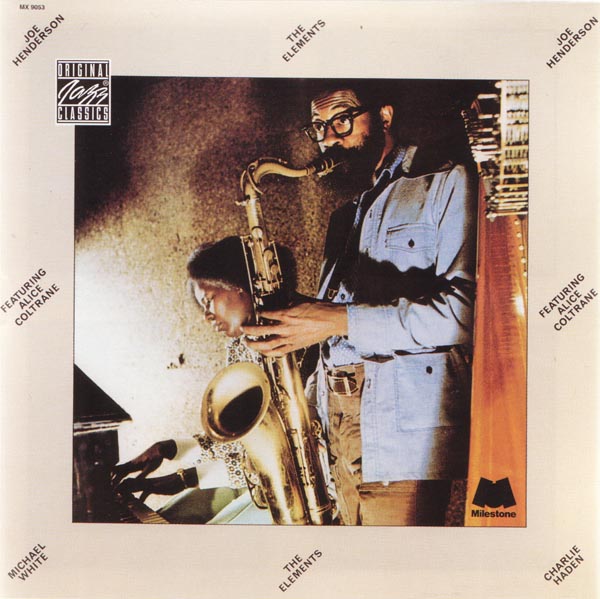JOE HENDERSON featuring ALICE COLTRANE


1/ Fire (Henderson) 7.30
2/ Air (Henderson) 4.01
3/ Water (Henderson) 7.49
4/ Earth (Henderson) 6.44
Recorded at Village Recorders, Los Angeles, California, October 15-17, 1973
Engineered by Rick Heenan
Remixed at Fantasy Studios, Berkeley, California
Remix engineer : Skip Shimmin
Produced by Orrin Keepnews
Remastered by Joe Tarantino 1996
Joe Henderson: tenor saxophone, alto flute, flute, piano (2); Alice Coltrane: piano, harp, tamboura, harmonium; Michael White (1,2,4): violin;
Kenneth Nash: wood flute (3), congas, North African sakara drum, Chinese bells, African bells, Indian bells, gongs, percussion, written and
spoken narration (4); Charlie Haden: bass; Baba Daru Oshun: tabla, percussion; Ndugu (Leon Chancler): drums (1,4).
1973 - Milestone Records (USA) (Vinyl)
1996 - Milestone Records/Fantasy (USA), OJCCD-913-2 (M-9053)(CD)
Scott Yanow (courtesy of the All Music Guide website)
“The Elements” is a conceptual jazz album – yes it’s not a Prog Rock exclusive – based on the four elements Zodiac signs and the Universe as the Ancients saw it is based upon; Henderson goes transcendental, mystic, spiritual or tribal and he does it with total commitment and belief. He sought further “illumination” inviting [Artiist4353] as his harmonic partner plus double bass giant Charlie Haden and percussionists Kenneth Nash and Baba Daru Oshun as permanent participants; violin player Michael White is featured on three tracks and drummer Leon "Ndugu" Chancler on two.
“Fire” builds up on an infectious Afro Funky bass riff, multiple percussions and a sensitive Ngudu soon joining the groove; the sax punctuates and adds blistering flights against open piano voicings; overdubbed flutes beef up the sound before White’s violin enters with a speech that reminisces Jean-Luc Ponty’s Free jazz era, and when the sax returns Alice C switches to harp, 1st with wide sweeping arpeggios, then with a solo that evokes the African kora; the relentless drive fades to leave Haden on his own with bells, percussions and drums before the theme briefly resumes with an ensemble ending.
“Air” and “Water” feature no drums; on the former Henderson initially builds upon Haden Free-tempo bass excursions as piano and percussions sprinkle the background; piano and violin join in and their triple mingling statements vary between wild and aggressive or lyrical and passionate, while the latter bathes in an Eastern vibe, via a tamboura drone; weird sax effects acoustic or electronic processed and a melodic explosion of cascading phrases and rhythmic patterns soar upon sparse bass chords and the violin which joins the droning effect.
“Earth” gets back to rhythm after a tablas intro; upon a syncopated slow bass pattern and a tamboura drone, sax and violin weave joint Afro/Eastern melodies as Ngudu punctuates the entrancing groove; Haden as a solo spot and he makes his bass behave like a lute slowly joined by the drone and discreet percussions; when harp and flute join in the contemplative mood a spoken narration highlights its spiritualness. But soon drums and bass reinstall the rhythm and violin and sax recreate the initial theme.
Perhaps because he choose a “palpable” theme to inspire this work, Henderson managed to stay away from the often painful Free excursions that marked the era; tortuous but melodic, tormented but soulful, this is a work that both points towards new directions and is highly entertaining, and simultaneously elevates Henderson to the small club of the true sax giants for whom the instrument has no secrets.
4 stars out of 5
comusduke (courtesy of the Rate Your Music website)